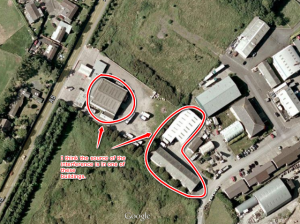The GB3IM-S amateur radio repeater on the summit of Snaefell was brought back into service on 17th March. This led me to discover that the output frequency of 433.125 MHz becomes unusable when driving through Ballasalla, due to some strong interference on that frequency.
Now, in these modern days where everything has a computer inside generating radio noise, a little interference on the 70cm band is to be expected. The difference with this one is its strength. I could hear it mixing with the repeater’s output right from the top of Fisher’s Hill, Castletown and again at the top of Brown Cow Hill, Santon. It was clear that the peak was somewhere around the level crossing as you drove through the village.
Relaying my findings to the regular members of the morning net on GB3IM, other amateurs confirmed that they’d heard it too. Over the next few days, people drove around, walked around, took bearings and we all seemed to agree on a rough location:

This evening (on my way back from Code Club) I parked up in this area, and took a walk around with my Yaesu VX-2 handheld radio. With the receiver switched to AM mode, and the built in attenuator switched on, I was able to tune to the edge of the interference at about 433.200 Mhz so that only very strong signals could be heard. This allowed me to walk up and down and see if the signal got stronger or weaker. After about 15 minutes, I’m fairly confident that the signal is originating from somewhere inside one of these buildings:

So, what is it? The signal seems to sweep rapidly across the RF spectrum, and appears to operate 24 hours a day, including weekends. It did seem to go off air on Tuesday 25th March but came back again. It sounds like it pulses at about 5 Hz, so maybe these are data frames for some networked device. Or maybe it’s a switched-mode power supply that has some kind of parasitic oscillation going on. Whatever it is, it probably shouldn’t be there.
The slight fly in the ointment is that the signal could be perfectly legitimate. In the Isle of Man (and the UK), the 70cm amateur band is a ‘secondary’ allocation. This means that the band belongs to another ‘primary’ user who has first claim on any frequencies. Given who the primary user of 70cm is (*cough cough*), I don’t think we’d ever find out if this signal is theirs.
Although I did notice that one of my suspect buildings was unmarked, with no hint of who owns it, or what is going on inside…

3 replies on “The Beast of Ballasalla”
Hmmm…
Suspicious….
Is this still going on?
No.
One of the local radio amateurs reported the problem to Ofcom. Their inspectors visited the island and confirmed our findings. The source of the interference was identified and the problem addressed.
Any other info you can tell us on what it was specifically?